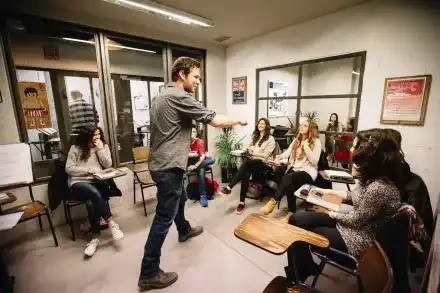PRESENTE CONTINUO EN INGLÉS
Hi everyone! 😊 ¿Todavía no tienes claro el uso del present perfect continuous en inglés? En este post os eneseñaremos qué es, cómo se forma, cuándo se utiliza y un montón de ejemplos para que se te quiten las dudas acerca e este tiempo verbal.
¡ALLÁ VAMOS!
¿Qué es el present perfect continuous?
El present perfect continuous es el tiempo verbal que utilizamos para describir acciones que empezaron en el pasado y continúan hasta el presente.
¿Cómo formamos el present perfect continuous?
Frases afirmativas:
SUBJECT + HAS/HAVE BEEN + GERUND
¡PISTA! ¿Sabes que es un gerund? Seguro que si os menciono la terminación –ing os sonará mejor.
Ejemplos: Running, Playing,Going, Talking
Ahora que ya hemos aclarado lo que es un gerund, vamos a poner unos ejemplos de frases afirmativas:
“I have been playing football for 10 years.”
“She has been studying at university.”
“We have been cooking all afternoon.”
“They have been arguing all night!”
Frases negativas:
SUBJECT + HASN’T/HAVEN’T BEEN + GERUND
¡RECORDATORIO! Las palabras hasn’t y haven’t son contracciones de la palabras has not y have not respectivamente.
Vamos a ver unos ejemplos:
“I haven’t been studying enough recently.”
“He hasn’t been feeling well lately.”
“They haven’t been shopping since last week.”
“We haven’t been seeing each other anymore.”
Frases interrogativas:
HAVE/HAS + SUBJECT + BEEN + GERUND
Ejemplos:
“Have you been fishing recently?”
“Has she been playing football?”
“Have they been winning their matches?”
¿Cuándo podemos utilizar el present perfect continuous?
Como hemos visto antes, este tiempo verbal lo utilizamos para acciones que empezaron en el pasado y continúan hasta el presente o han acabado recientemente.
En muchos ejemplos hemos utilizado las palabras since y for. Estas dos palabras las utilizamos para expresar un período de tiempo. También, hemos utilizado recently y lately, que so adverbios de tiempo y expresan acciones recientes.
Present perfect vs present perfect continuous
Entre estos dos tiempos verbales puede haber mucha confusión. Ahora vamos a ver cuando pueden significar lo mismo y cuando tienen un significado diferente.
Los verbos “live”, “walk”, “study”
Con estos 3 verbos, el significado de la frase no tiene ninguna diferencia. Ejemplos:
“I have lived here since 2005.”
“I have been living here since 2005”
“They have walked for 3 hours.”
“They have been walking for 3 hours.”
“He has studied since he was a child.”
“He has been studying since he was a child.”
¿En qué se diferencian?
Present perfect continuous da más énfasis
“They have played really well.”
“They have been playing really well!” (Aquí se muestra más énfasis)
“We have talked for hours”
“We have been talking for hoooooours! (Se vuelve a mostrar más énfasis)
Present perfect continuous no se puede decir para “HOW MANY?”
“I have drank 3 coffees”
“She has played 4 games.”
“I have been drinking 3 coffees.” INCORRECT
“She has been playing 4 games.” INCORRECT
¿Qué os ha parecido? Recuerda que Number 16 tiene una academia de inglés en Bilbao. Ven y pídenos info acerca de nuestros cursos de inglés, ¡os esperamos!
SEE YOU SOON! 😉
Pronunciación avanzada: entrena acento británico y americano online
Técnicas y herramientas para mejorar tu pronunciación en inglés (británico y americano) con feedback automático y ejercicios prácticos.
Clases híbridas de inglés: cómo combinar presencial y online de forma óptima
En los últimos años, la enseñanza de idiomas ha avanzado de manera acelerada. Entre las metodologías más efectivas nos encontramos el modelo híbrido, una combinación de clases presenciales y online que potencia el aprendizaje.
Por qué ya no se canta God Save the Queen: historia reciente del himno
Descubre el cambio de letra del himno británico tras la muerte de la Reina y datos curiosos sobre su historia.




